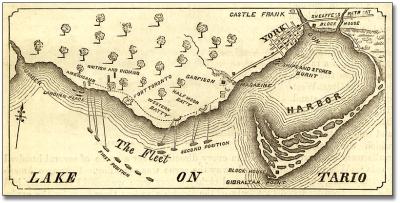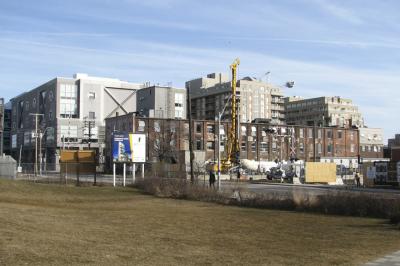 |
April 26, 2013
The April 27, 1813 American Attack on York (Toronto)
|
The War of 1812 which started in Mid 1812 and ended 30 months later in 1815
is being recognized with books, plays, films, re-enactments, etc. Pierre
Berton’s book Flames Across the Border is an easy read on the 1813-14 part of
the war. He also wrote a book on the 1812 part of the war. The first chapter in
the 1813-4 book tells the story of what he calls the Capture of Little York
April 26-May 2, 1813.
It was clearly a strange war fought only in good weather, with poor
communication and people on both sides sympathetic to the other making it in one
sense a civil war or an attemt to complete the American war of independence The
recognized best book on the war by Alan Taylor is called The Civil War of 1812.
He points out the miscommunication, the incompetent leadership and the slaughter
of many who had no interest in the war. The fancy red and blue uniforms in many
reenactments are a joke as compared to the ragged and worn actual uniforms.
Berton points out that the daily booze ration sent many into battle inebriated.
The Canada/U.S. maritime provinces and states didn’t participate and life went
on as usual.
 |
| Early drawing of York on April 27, 1813. New York State
Library |
In the spring of 1813 the Americans felt that they could win the war if they
could control the waterways. In the winter of 1812-13 they built a variety of
ships for Lake Ontario use. They intended to attack Upper Canada’s key military
location in Kingston and stop communication and supplies to Lower Canada and the
west end of Lake Ontario and win the war. Berton says they attacked a branch
rather than the trunk.
The Americans did want the fine ship - The Isacc Brock being built at York
and 2 other York Ships. They captured York but the Brock was burned as was one
of the 2 on the lake. The third was not in port.
Most of the troops were in Kingston so the Americans had an easy time taking
York. They landed west of the town near the now CNE grounds and fought some
Indians and proceeded toward the town. The militia was slow to organize and was
poorly trained and many were recent American immigrants. The Governors
headquarters was captured and burned and they headed toward the grand magazine
where a huge cache of ammunition was stored- some for pending shipment to
locations to the west down the lake. The magazine was torched and it exploded
killing many Americans including their General and many Upper Canadians. By this
time theCanadian soldiers had retreated toward Kingston abandoning the town. The
Parliament Buildings were burned and York capitulated (see my article on the new
Parliament Buildings Museum – Google Heritage Perspectives and click on article
413).
The Terms of Capitulation included the promise to protect private property
but the American soldiers looted the town anyway.
Berton writes at length about the Reverend Dr. John Strachan who overroad the
Canadian Military leadership. He later went on to become the leader of the
Family Compact which did not see civil liberties as a concern and saw
individualism, liberty, and democracy as American concepts. This was the basis
of Canadian conflict in future generations.
It should be mentioned that the Americans came back to York on July 31, 1813
and burned more barracks and storehouses and released American sympathizers who
had been jailed. They left a couple of days later.
Revenge?
It should also be mentioned that as the war in Europe with Napoleon ended the
British had ships and men available in the war. In August 1814 what has been
characterized as revenge for York the British attacked Washington and burned the
town including the White House – a name given later when white paint was used to
repaint the burned building.
Fort York Today
Toronto grew to become the remarkable city it is today and Fort York became a
Canadian Historical Site with historic 8 War of 1812 buildings – the largest in
Canada. Many new buildings have been added and a new bridge and visitor centre
are being added.
On April the 27th this week a long walk will take place, with Interpretors
ending at York. At the Parliament Buildings there will be a 6am sunrise ceremony
by the Mississauga First Nation and 3 other First Nations all of whom fought in
the War of 1812.
A Military Parade of a 1000 military, including 13 marching bands will follow
the presentation of new colours to the Royal Canadian Regiment. The parade will
end at Fort York where a new First Nations Plaque will be unveiled with displays
and other activity.
 |
Former J.B. Smith Lumber Mill and Yard – now Strachan House. David Spittal,
Toronto Culture photo. |
A Local Footnote
The Friends of Fort York group of active historians does remarkable work.
They have a newsletter The Fife & Drum. One of their members wanted to do a
story on the large building on the edge of the Fort property where a new bridge
was pending and had along conversation with me. The building was theToronto
headquarters for Callander’s John B. Smith Lumber Company that operated in
Callander for over 100 years. I had written about the company in several
articles. Their March 2001 Newsletter is online and provides an excellent
history on the Smith operation with a fine photo of JB. The building has been a
restored facility for the homeless since 1996.You can still make out some of the
original Smith signage.
Heritage Perspective Home Page
| 
![]() Past
Forward is now on Facebook "LIKE" us to keep in touch
Past
Forward is now on Facebook "LIKE" us to keep in touch